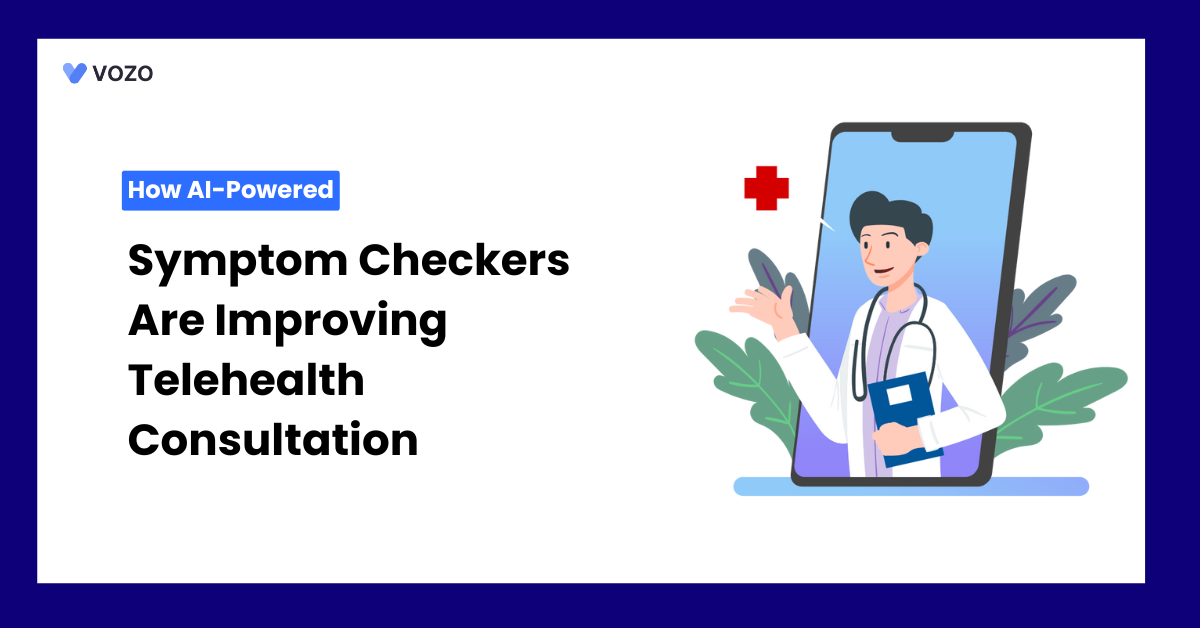How AI-Powered Symptom Checkers Are Improving Telehealth Consultation
Telehealth visits have increased by 150% recently, according to reports. Around 70% of patients now prefer virtual visits over in-person ones. This rise in telehealth is shaping the healthcare system. Digital tools now speed up and improve the consultation process. These tools also make healthcare more accessible and convenient for many.
Especially, AI-powered symptom checkers help healthcare providers assess patients’ conditions more quickly. They gather important information and guide patients toward appropriate next steps. In this blog post, we have shared how AI-powered symptom checkers are improving telehealth consultation.
The Challenges Associated with Traditional Telehealth
Traditional telehealth systems often confuse many patients today. Moreover, many online forms require lengthy questionnaires that overwhelm users easily. Some of the challenges associated with traditional telehealth include:
- Limited interactivity significantly reduces clear communication between providers and the patient.
- Users frequently experience severe misinterpretation of their critical health symptoms.
- Poor design sometimes leads to delayed patient response and care.
- Old systems often lack sufficient language options for clarity
Moreover, outdated methods increase errors and hinder accurate diagnosis seriously. Furthermore, current technology struggles to capture individual patient health details.
In addition, rigid templates severely limit the depth of information. Consequently, traditional telehealth often falls notably short in overall performance.
Related: 5 Ways Vozo Telehealth Makes Virtual Health Consultation Better
The Impact of Inefficiency in Telehealth
Inefficiency in digital care systems burdens both patients and providers.
- Unexpected delays in care can worsen patient conditions over time.
- Incomplete patient data forces extra work for busy physicians. Errors in data consistently lead to higher misdiagnosis rates.
- Operational inefficiencies significantly increase costs, and patient distress alike, and create constant stress among overworked medical staff.
- Waiting times become longer during peak service hours.
- Patient trust in telehealthcare systems declines steadily overall.
- Heavy administrative burdens reduce the time for quality patient care.
Overall, inefficiency weakens telehealth by hindering timely and effective care.
How AI-Powered Symptom Checkers Are Improving Telehealth Consultation
AI-powered symptom checkers effectively streamline the patient telehealth consultation process.
- Firstly, they analyze user inputs with careful and structured questioning.
- Then, precise results are generated using vast medical knowledge bases.
- Subsequently, accurate suggestions quickly match symptoms to proper care needs.
These tools reliably provide immediate steps for potential treatment. Furthermore, they consistently lessen the wait before receiving professional care.
They empower patients by clearly clarifying their health situations. Next, providers immediately receive comprehensive detailed, organized reports before teleconsultations. Then, informed decisions are made using better clarity and access to patient information.
Overall, AI-powered checkers significantly improve care through efficient symptom analysis.
1. Quickly Review Symptoms and Suggests Steps
These systems quickly review all reported symptoms for immediate clarity.
- Initially, they capture every single detail without delay or error.
- Then, concise follow-up questions help narrow down symptom possibilities accurately.
- Each answer consistently refines the symptom review for precision.
This process speeds up by eliminating all redundant inquiries. Then, clear suggestions emerge with each reviewed symptom input quickly. The system effectively guides users to seek appropriate care.
Also, a concise summary appears to direct the next actionable steps. This way, the patients feel greatly reassured by clear, step-by-step advice. Overall, rapid symptom review guides users with trusted, timely suggestions.
2. Prioritizes Care Based on Urgency
AI-powered symptom checkers in telehealth accurately assess urgency by analyzing symptom severity promptly. It will help healthcare professionals by:
- Initially, clear red flags are noted to signal urgent care.
- Then, lower risks are scheduled promptly for regular follow-up consultations.
- Moreover, they automatically flag severe symptoms requiring immediate professional intervention.
Furthermore, urgency levels effectively help prioritize scarce healthcare resources efficiently. Patient cases are ranked to ensure critical treatment promptly. Then, response teams can act on urgent cases without delay. Also, clear prioritization consistently reduces confusion during busy healthcare periods.
Moreover, patients receive much faster care when urgency is recognized. Overall, proper urgency assessment significantly improves outcomes in telehealth services.
Related: Top Benefits of Telehealth for Urgent Care: A Guide for Providers and Patients (2025)
3. Accessible Anytime for Immediate Help
These systems remain accessible 24/7 for urgent patient assistance.
- Users can easily check symptoms at any time without waiting.
- Then, prompt guidance is reliably provided at any given moment.
- Round-the-clock service reliably supports medical emergencies during odd hours.
Also, immediate help consistently reassures patients facing urgent health concerns. Rapid response consistently builds confidence in telehealth services. Users feel truly empowered by continuous access to support. The service effectively bridges gaps in traditional healthcare settings.
Moreover, constant availability ensures quicker responses during patient emergencies. Anytime access significantly improves telehealth care and patient outcomes.
4. Collect symptoms to Save Time
AI-powered symptom checkers in telehealth systems efficiently and quickly gather symptom data.
- Firstly, simple digital queries capture detailed patient symptom information promptly.
- Then, collected data is organized for faster review by professionals.
- Unnecessary data repetition is greatly reduced during patient consultations.
Organized data consistently saves time for busy medical teams. Also, quicker data collection leads to prompt care and treatment. Then, reduced waiting time significantly enhances patient satisfaction and comfort. Moreover, efficient data collection markedly speeds up overall consultation processes.
Next, experienced providers use this information to focus on treatment. Overall, quick symptom collection significantly saves precious time in healthcare.
5. Offers Providers Useful Patient Details
These systems compile essential details about each patient very quickly. Firstly, collected data is structured in clear, simple, readable formats. Then, complete health history and symptoms are combined for context. Moreover, detailed patient records to aid in accurate diagnosis and planning.
Patient information is updated regularly with recent health data. Also, comprehensive summaries consistently support effective consultation preparation by providers.
Next, crucial details are highlighted for swift decision-making. Then, skilled providers carefully review patient details before each teleconsultation.
Moreover, complete records enable highly targeted and personalized care planning. Overall, structured patient details significantly enhance consultation effectiveness every day.
6. Provides Tailored Guidance for Symptoms
AI-powered symptom checkers in telehealth systems offer personalized advice tailored to each reported symptom. This system helps to:
- Compare gathered details against trusted health guidelines immediately.
- Then, personalized care recommendations are promptly generated for each case.
- Moreover, clear guidance effectively directs patients toward the proper next steps.
Recommendations consistently consider urgency and detailed symptom factors. Customized advice also effectively helps patients manage care at home.
Next, suggestions may sometimes recommend over-the-counter options for quick relief. Then, advice seamlessly adjusts based on user feedback during interactions. Moreover, the system reliably personalizes guidance to meet individual needs. Overall, tailored guidance effectively empowers users to take informed actions.
Vozo Telehealth Solution
Telehealth offers significant benefits for both providers and patients. Leveraging the Vozo Telehealth and EHR Integration can streamline your healthcare practice’s workflow.
With a vast range of features, such as scheduling appointments, audio/video/text consultation, analytics & reporting, better access to care, etc, healthcare providers and patients can:
- Reach out to patients remotely, ensuring more flexibility around appointment times.
- It saves patient travel time and makes fitting appointments into busy schedules easier.
- Vozo Telehealth allows anonymity and ensures patients feel more comfortable opening up from the privacy of their home space rather than in-person therapist visits.
- This eliminates the transportation cost of getting to appointments.
- It also reduces overhead costs like rent and admin staff for therapists who can conduct remote sessions, and many insurance companies also cover teletherapy.
- Vozo Telehealth makes it easy to maintain regular appointments, especially for patients who travel frequently or move locations.
- Therapists and patients can connect through the telehealth platform from anywhere.
The Vozo Telehealth solution enables providers to reduce burdens and focus more on better patient outcomes remotely.
Reach out to Vozo and utilize cutting-edge telehealth solutions for better convenient quality healthcare.
About the author

With more than 4 years of experience in the dynamic healthcare technology landscape, Sid specializes in crafting compelling content on topics including EHR/EMR, patient portals, healthcare automation, remote patient monitoring, and health information exchange. His expertise lies in translating cutting-edge innovations and intricate topics into engaging narratives that resonate with diverse audiences.













